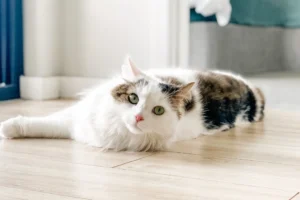Have you ever wondered why cat paws are so irresistibly soft to the touch? Let’s explore the science behind their velvety texture.
Anatomy of a Cat’s Paw
You know how when you feel a cat’s paw, it’s like touching a cloud? Well, that softness isn’t just for show; it’s all in the anatomy of their paws. So, let’s break it down.
Cats have a layer of fat underneath their paw pads. This fat pad not only adds a cushiony feel but also helps with shock absorption when they’re on the prowl or playfully batting around a toy mouse. Plus, their paw pads are covered in thick skin that’s densely packed with sensory receptors – almost like a built-in pair of fuzzy slippers with ultra-sensitive soles. This combo of fat and skin is what gives their paws that velvety softness you can’t resist touching.
And get this – their claws can retract, which means these soft paws are always ready for a gentle caress or a stealthy sneak attack. Talk about versatile!
Functionality of Soft Paws
Now, you might be thinking, “What’s the big deal about soft paws?” Well, buckle up because there’s more to it than meets the eye.
Those soft paws aren’t just there to be petted; they’re essential tools for your feline friend’s daily adventures. The softness of their paws helps them move quietly and gracefully, whether they’re stalking prey or tiptoeing across your living room furniture like tiny, furry ninjas. It also allows them to navigate various terrains with precision, from plush carpets to rough tree bark.
But here’s the kicker – those soft paws are also key players in your cat’s grooming routine. They use their paws to lick and groom themselves, spreading natural oils from their skin to their fur for that purrfectly sleek coat. So, the next time you see your cat grooming themselves, remember, it’s all thanks to those oh-so-soft paws.
Bonus Tip: Paw-some Care
To keep your cat’s paws in top-notch shape, give them a paw-dicure every now and then. Trim their claws, inspect for any signs of injury or irritation, and gently clean between their toe beans. Your feline friend will thank you for the extra love and attention to their precious paws.
Factors Affecting Paw Softness
Did you know that a cat’s paw pads are naturally soft and supple? This unique feature is influenced by various factors such as genetics, grooming habits, and environmental conditions. Genetics play a significant role in determining the texture of a cat’s paw pads. Some cats are simply born with softer paw pads due to their genetic makeup. Additionally, regular grooming habits can also contribute to maintaining the softness of a cat’s paws. Cats that groom themselves frequently tend to have smoother and softer paw pads compared to those that do not groom as often. Furthermore, environmental conditions can impact the softness of a cat’s paws. Dry climates or rough surfaces can cause a cat’s paw pads to become rougher over time. Therefore, ensuring your feline friend has a comfortable environment and practices good grooming habits can help keep their paws soft and healthy.
Comparing Cat Paws to Other Animals
When it comes to comparing cat paws to other animals, felines are known for their unique combination of softness and functionality. Cat paws are not only soft to the touch but also highly functional, equipped with specialized features that make them agile hunters and climbers. Unlike dogs, whose paw pads are tougher and more durable for activities like running and digging, cats have softer paw pads that provide them with sensitivity and traction needed for stalking prey and navigating various terrains. In comparison to other animals, such as bears with their large, sturdy paws designed for powerful movements, cat paws stand out for their delicate yet efficient structure. So, the next time you feel the gentle touch of your cat’s soft paws, appreciate the perfect balance of comfort and capability they offer in the animal kingdom.
Fun Facts About Cat Paws
Did you know that cat paws are not just cute but also incredibly functional? Cats’ paws are designed to help them navigate their environment with precision and agility. Each paw has five toe pads, along with a larger central pad, which helps distribute their weight evenly as they walk, jump, and climb. Not only that, but a cat’s paw pads also act as insulation, providing protection from extreme temperatures. Additionally, the pads contain sweat glands that help regulate body temperature. So, the next time you marvel at your feline friend’s soft paws, remember that they serve an essential purpose beyond just being irresistibly pettable.
Proper Paw Care Tips
Taking care of your cat’s paws is crucial to maintaining their softness and health. To keep those adorable paws in top condition, make sure to check them regularly for any signs of injury or infection. Gently wipe their paws with a damp cloth to remove dirt and debris, especially after they’ve been outdoors. Trim their nails regularly to prevent overgrowth and discomfort. You can also apply pet-safe paw balm to keep their pads moisturized and protected. And don’t forget to provide plenty of scratching posts to help them naturally maintain their claws. By following these simple tips, you’ll ensure that your feline companion’s paws stay soft and happy.
Paw Care Tip: When trimming your cat’s nails, it’s essential to use proper pet nail clippers and avoid cutting into the quick, which can be painful for your furry friend. If you’re unsure about how to trim their nails safely, don’t hesitate to seek guidance from your veterinarian or a professional groomer.
Mythbusting: Common Misconceptions About Cat Paws
Cat paws are undeniably adorable, but let’s separate fact from fiction when it comes to these fuzzy little appendages. One common myth is that a cat’s paw pads are as soft as marshmallows. In reality, while they may feel plush to the touch, they are designed to be tough and durable to withstand everyday activities like walking, climbing, and scratching.
Another misconception is that a cat’s paws are always warm. While your feline friend may enjoy curling up on your lap and keeping their paws tucked in for added warmth, their paws actually serve as a natural temperature regulation system. Cats have sweat glands located on their paw pads that help regulate their body temperature, so their paws can sometimes feel cooler than the rest of their body.
It’s also a common belief that cat paws are naturally clean and do not need regular grooming. While cats are meticulous groomers, it’s essential to help them keep their paws clean to prevent dirt, debris, and potential infections. Regularly checking and cleaning your cat’s paws can help maintain their overall health and well-being.
Remember, while cat paws may seem like magical little cushions, they serve crucial functions for your feline friend beyond just being irresistibly soft.
The Bonding Power of Cat Paws
Cat paws aren’t just cute accessories; they play a significant role in strengthening the bond between you and your furry companion. The softness of a cat’s paws creates a sense of comfort and trust when they knead or pat you with gentle paw movements.
The act of kneading, where cats rhythmically push their paws in and out against a surface, is a behavior often associated with feelings of contentment and security. When your cat kneads on your lap or blankets, they are instinctively marking their territory with the scent glands located on their paw pads while expressing their affection for you.
By engaging in interactive play that involves your cat’s paws, such as gentle petting or playing with toys, you can further strengthen the bond between you and your cat. Spending quality time together and respecting your cat’s boundaries when it comes to their paws can help nurture a deep connection based on trust and love.
Remember, the softness of cat paws is more than just a physical trait; it’s a gateway to building a strong, lasting bond with your feline companion.
Alex, a passionate animal lover, has experience in training and understanding animal behavior. As a proud pet parent to two dogs and three cats, he founded AnimalReport.net to share insights from animal experts and expand his knowledge of the animal kingdom.









